Lecture
An example of unobtrusive monetization
Now it has become very fashionable to scold free-to-play monetization and generally f2p games in general. Moreover, it is not going anywhere, and despite the cries of the disgruntled, it inevitably occupies an increasing part of the gaming market. The funniest thing here is that 99% of people do not even have a close idea of what it is and what it consists of. I'm not going to talk here on the topic of good or evil, this is a separate conversation. Now I want to talk about monetization and the basics of f2p and what it consists of. This is a dry practice, without value judgments, which can help you in planning your game. Or even save from creating a loss-making game that consumes more than it brings. In the end, I will even give an example of the successful use of such prototyping from real life.
Before embarking on technical issues, there will still be some lyrics. First of all, about the role of game designer in the project. There is a common misconception that "game designer should do balance and gameplay," and the rest does not concern him. I do not agree with this for the reason that no one knows the game better than gamediz and will not know how to monetize the game well and efficiently. If the company has a marketing department, then that's fine, but mostly these guys solve external issues. Yes, I was lucky to work with several marketers who delved into the depths of the game, who had an analytics department and mechanisms built into the game that showed problem areas. And often the ideas or solutions offered by the marketing department were right. But such professionals are very rare. Basically, decides what and how to monetize the producer / customer (rarely) or game designer (often). Without having the necessary knowledge and skills, the monetization will go blindly, lose something somewhere, pinch the players somewhere and drive them out of the game (hello, EA).
Whether to deal with the monetization mechanism itself or not, or whether gamediz or someone else should deal with it, the team will decide. But gamediz is required to know at least the basics of a monetization mechanic, and now I want to tell about them.
Any f2p game operates with a standard set of parameters that determine its commercial success (or failure). I will go consistently, from the moment a player comes into the game and traces his life there.
The price of a player is how much it costs to attract and engage in a game of advertising. I consider the simplest situation, consciously leaving the players who came through viral mechanisms and whose value is very difficult to estimate. Your advertising is worth something, in each market the cost varies. For example, now the average cost of attracting a player to a mobile game is about $ 1, to the browser it can range from $ 0.5 to $ 2 (industry leaders can pay for quality traffic (see below) and more). Knowing the price of a player in your market is vital. It is even better to get data on the value of a player in your market from similar games.
Decoding: CPR - Cost Per Registration; CPI - Cost Per Install; CPA - Cost Per Action.
How it works: you give advertising, you have a thousand transitions and two hundred of those who have come have registered in the game. Your first conversion (first threshold) is 20%. This is a smart conversion, by the way. Obviously, the higher the conversion, the better you are. Therefore, the monitoring of this threshold is mandatory (like all others) and we must work with it first. If you have a low input conversion, then you did something wrong and you need to fix / improve something, remove obstacles from the players' path.
For example, incoming players must go through complex registration with captcha, which can be guessed from the tenth time. Compare this with the player, where registration is postponed and can be carried out after the player has pressed the "play" button, watched the game, got involved and has already become a player, bypassing the first obstacle. Obviously, in the second case, the first conversion will be significantly higher.
In addition, the first conversion can also show the quality of traffic. For example, you paid for advertising a game that you hung on a refrigerator sale site where people go to buy a refrigerator. They can click on the banner (if it works), but it’s unlikely that many of them will be distracted from their original goal. The second type of bad traffic is bots, when the platform wants to make easy money on your banner and spin clicks. Again, if you do not have monitoring of these statistics, then you miss these two points.
The next conversion is how many players from those who came will become active, and how many will leave after registering in the game (or seeing the game, they did not like it and they left). It looks when the players reach certain indicators that you consider key: X hours in the game, the player has reached level X, has completed some kind of quest or something else. If you see that the players pass the first threshold well, but fall off on the second, then the retention mechanisms are poorly tuned in the game (or the game is simply of poor quality). But the rule of thumb: if the players have registered and started to play, then they can be converted into active ones, if you know how, and understand at what point they experience difficulties and leave.
An interesting case in life: they made a very beautiful and promising landing page in a morally obsolete game ... and the conversion decreased. Players who saw modern art in the process of entering and registering, fell into the game of the past generation and were disappointed. When they returned the old landing, suitable for the "spirit" of the game, the same traffic showed a conversion of several percent higher (by the way, a few percent is a lot).
What happens after a player becomes an active player in a free-to-play game? He either becomes paying (of different quality), or plays for free. I can not say that this conversion is more important than the previous ones, no, they are all equivalent. Here, the task is to make the player comfortable to pay, the payment would be affordable for him and would not scare him. If the conversion is too low, the prices are too high, or the “non-paying” traffic enters the game: for example, your game is aimed at people 25+ years old, and you are overtaken by schoolchildren from 7B who have no money. If the conversion in the payer is very high, then you probably do not get enough, but here you have to look: if you raise the prices for X, then how much will the conversion to payers decrease and how will this affect the profitability?
Many players can pay, but do not know how. The activation payment task is to teach players to do this. The activation payment is usually the lowest possible and gives the maximum number of bonuses, discounts, rewards and all other things to the player. This offer is one-time and must be such that the player is ready to go for a wallet, get his card and spend time to pay for this offer. Instead of a card, it could be PayPal, SMS or something else, but the principle is clear. According to statistics, players who have paid once every little thing, it is easier to pay in the future for something more expensive and valuable. Ideally, you store payment information and the player does not need to re-enter all this - just enter the password (or CVV code) and press the confirmation button.
Average Revenue Per User - the average payment for all registered players. That is, you had 10,000 registrations for all the time, you earned $ 2000. We divide $ 2000 by 10 000 and we see that the average payment is $ 0.2. Despite the apparent simplicity and mathematical correctness of this indicator, it is not accurate and can be misleading. For example, over the last month you have invested $ 25,000 in advertising and received +25,000 registrations, but these users have not had time to pay, or even completely left after registration. As a result, when studying ARPU, you will get terrifying indicators that will tell you that it is time to close the project, and you do some other work. In fact, this is not the case at all. To see a more correct picture, there is an ARPAU record.
Average Revenue Per Active User. This is almost the same, but only payments of those who really became a player here look. This is a more valuable and reliable indicator, as it cuts off the registration of bots or massive advertising campaigns, which will give effect only after some time. But in my calculations I still operate with a more complex indicator, which seems to me more convenient and is called ARPPU.
As someone probably knows, and another may have guessed, this is Average Revenue Per Paying User. That is, the average payment for all those players who paid at least one penny for the selected period (the period can be anything from one day to the entire life of the game from the moment of the first payment). Obviously, if ARPU is minimal, ARPAU is higher and the market average (browser) varies between $ 2-3, then ARPPU is several times higher and, good for the market, ranges from $ 25 to $ 50 (excluding social networks, which are lower and in which payments much lower). The spread is so large because of the presence of different genres, audiences, platforms. Before thinking about monetization, I would definitely advise you to explore your market, platform and get information on ARPPU of similar games in any (legal, of course) way.
Regardless of the type, platform or genre of the game, players tend to leave. The time they spend in the game from the moment they register to the moment they stop entering is called the player’s lifespan. The indicator is important: if you don’t put it into a business plan or a prototype of monetization, then the monetization indicators (and many others, for example, the amount of organic or viral traffic) will be overestimated. What it can lead to, I think, is not worth talking. Therefore, knowing the average life of the players in the game is necessary. In addition, the way you should monetize your players directly depends on this.
For example, in mobile games, the average player’s lifespan can be about a month, and in hardcore games like Eve Online - six months (these values are taken from the ceiling, you don’t need to rely on them). But what should be kept in mind: if you make a mobile game that starts to monetize from level 50, to which you need to play for a month and a half, you will most likely earn very little. It is clear that they need fast monetization, which can be quite intrusive and aggressive (ethical moments overboard). Conversely, if you embed quick monetization into a hardcore game, then it is very likely that you will lose a lot of players, meaninglessly scaring them away with a premature offer. Instead, if you know that your players will live for several months, would it not be better to convert them into active and loyal players first, immerse them in the game universe and then make an offer to part with their bloodlines?
Despite the fact that I have described only the basic concepts and terms, without delving into organic traffic, viral traffic and much more, these parameters are quite enough to jot down a simple prototype of monetization in Excel. Of course, in order for it to make sense, we need reliable and relevant source data. It should also be borne in mind that in six months (or at the time of the release of your game), the data may become outdated, and the market will change. Therefore, such a prototype should be treated very carefully and not make it the foundation on which your entire business will be laid.
On the other hand, this model works well as a tool for monitoring the situation in an existing project. For example, in a few months (with more or less tangible traffic), you will have your own indicators, true for your market, platform and genre. They will give a completely clear and understandable vision of the picture and a forecast for the future, as well as help to see problem areas. Of course, all this is true, provided that all these statistics are collected and recorded.
Finally, I will give an example from personal experience, when a similar prototype (only of course more complicated, developed by joint efforts of 4-5 people, including myself, marketers and analysts). The financial model of the game for social networks was built, which showed that with our input data the game could not pay off in any way, regardless of advertising: at a cost of attracting a player about 15 rubles, ARPPU was no more than 500 rubles. The planned conversion rates into players and then into those paying for the selected genre are not very high. All this showed the future unprofitability of the venture, if we use only advertising. But since the game is for social networks, virality is a natural way out of the situation: with qualitative virality (130% +), the indicators are already positive. What did it give us? Change of development priorities: virality to one of the first places in the queue for developing, designing and integrating additional virality mechanisms into the project.
In one of my previous articles about the problems with free-to-play, I promised to tell you what “ good free-to-play monetization” is . As I wrote this article, I decided not only to talk about the principles of monetization of the “right” one, but also to give examples of what ways there are in general. With proper use of the described principles and mechanics, as well as in controlling their appetites, they will not have a negative impact on the players or their attitude towards you. Of course, the examples given are just a tiny part of all the endless and unlimited number of ways to monetize the game. Basically, they are universal and suitable for most games. But in addition to them, for each genre and type of game you can come up with a huge number of options that will work there and will not work anywhere else. Conversely, some of the methods described below still do not fit all games because of their specificity.
Free-to-play monetization happens to be “correct” - humane, when players pay voluntarily, and pay-to-win. Pay-to-win forces players to pay, and if they don’t do this, they obviously lose to either other players (who has paid the most, is stronger) or the game itself (they can’t pass the level, constantly die, get stuck at some stage of development and will not overcome it until they pay). This is the main reason why players do not like the free-to-play system and consider it an “evil” and inhuman money-press, and the developers of such games are greedy rascals. This is very sad, because in fact, free-to-play (if used correctly) is the most humane system that benefits both developers and players. I think it is already clear that I consider it a system in which the players play freely and comfortably and do not find themselves in a situation where they have to either pay or leave the game, as a good free-to-play monetizate. In addition, with its correct implementation, players without paying a penny can also get most of the paid content. Of course, there must be a condition that they invest enough time and effort, otherwise premium content will be discounted and monetization will not work. The ideal implementation f2p happens when and the wolves are fed and the sheep are whole and the players are satisfied, and the developers get their money for further development and existence.
I want to once again quickly run over the fact that there is a “bad” monetization and why I consider it bad. The main reason, from the point of view of the developer, is that such a system burns out players very quickly. By the time they manage to come to their senses, their wallets and bank accounts, if they don’t get empty, they noticeably lose weight. The task of such monetization is to squeeze out a maximum of money from a player as quickly as possible and efficiently until he realizes what is happening and has not abandoned the game. I do not think that this is good and useful either from the point of view of business, or from the point of view of forming a community or a company’s reputation. Of course, it works on the stream, when games are stamped for several months and players, having become disillusioned with one, go to another ... exactly the same, often - the same developer or publisher. But smart guys have long understood that it is impossible to do this in the forehead and such things intelligently mask and soften. A good monetization, on the contrary, cherishes players and gently ties them to the game universe, forcing them to return for many years, not only without causing a negative, but on the contrary, it gives rise to positive emotions.
This concludes with the introduction and now you can proceed directly to the methods themselves, which I consider to be soft and extremely optional.
The most common and usual way of monetization, which can be very easy and positive, and hard, negative. The price of currency and the simplicity of its extraction in the game determines what method it will be. For example, if the currency in a game is given to players only when they reach the next level in small quantities, then players will have to buy it and this will, almost guaranteed, pay-to-win. If a currency is given too often and easily, almost no one will buy it and it will be devalued.Here you need to carefully consider the economic system in the game and create a moderate deficit, without distortions in one direction or another. A great example is Hearthstone from Blizzard, where currency is earned relatively easily and you can receive several boosters each day (sets of five random cards), but to get the rare cards you need, you either need to spend a lot of time and spend a lot of games, or pay money available to each player and buy 40 boosters at once (the price of such a purchase is only about 1600 rubles). To get all the rare cards, depending on luck, players will have to make 5-6 such purchases. Or play a few months every day, completing tasks and earning game currency, or playing in arenas (successfully).
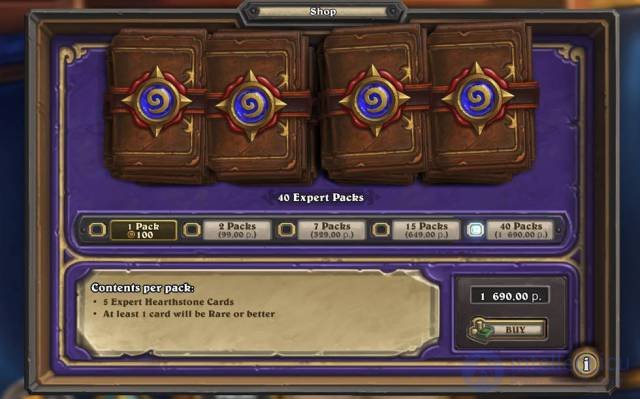
Hearthstone: a special offer that is hard to refuse
A good example is poker (and other casino games) in social networks: players get chips every day, losing that they can either wait for the next day and free replenishment, or buy a lot of them at once and play for fun. An example of the proper formation of a special offer is the well-known “Candy Crush Saga”, which is in the top in terms of both profitability and popularity.
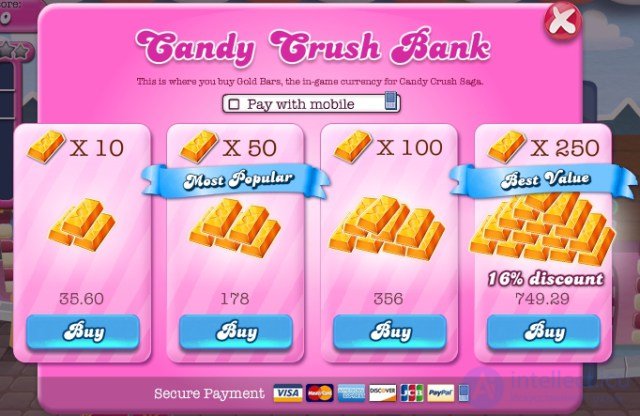
Candy Crush Saga: awesome bonuses for buying game currency
При создании системы с продажей игровой валюты особое внимание следует уделить тому, что именно могут купить на нее игроки: ведь если нет интересного предложения, желанных товаров и услуг, то и покупок не будет. Я сознательно не делю игровую валюту на «реал» и «фантики», потому что это уже нюансы реализации и где-то может быть деление на две (или даже несколько) валют, а где-то это вовсе не нужно.
Время — деньги. Во фри-ту-плей играх это очень важно понимать. Жизнь, в большинстве случаев, устроена очень просто: у одних игроков много времени и мало денег, у других — много денег и мало времени. Что, в общем-то, логично. Первые не монетизируются и делают свой вклад в игру своим временем. Вторые не могут играть много, но не хотят уступать первым. И тут разработчики сталкиваются с первым искушением: сделать ряд товаров за реальные деньги, которые усилят платящих и уравняют их с теми, кто много играет. И часто делают роковую ошибку, потому что забывают монстрах, у которых есть и много денег, и много времени. Это приводит к тому, что эффективность таких игроков значительно превышает и эффективность не платящих игроков, и эффективность обычных платящих, что приводит к недовольству и первых, и вторых. Представьте себе что игру, в которую играет несколько сотен тысяч человек, может «испортить» присутствие всего пары десятков таких монстров. А то, что они будут — это гарантированно (если у вас будет сообщество и игра «пойдет»).
How to do it right? Sell something that shortens the time of pumping. For example, you can sell buffs that give a bonus to the experience gained. You can sell accesses in locations where more experience is given (or something else). But in no case do not sell the experience itself or skills: this will lead to the fact that players will buy them, but they will not be able to play, since they did not spend any time on the game itself. Their purchases will give them practically nothing that will turn them into a waste of time.
What else can you offer them? Many things. Expedited relocation if you have a map. If this is a fantastic game, then teleportation for real money between cities can be instantaneous, and for free it can take some time (right up to the day of real time). You can offer cars. Shortened respawn time if there is a cooldown after death. Give bonuses to points earned, if the game has points and they affect the progress. Give a bonus to the game currency falling from the monsters, if the game has a drop and a shop.
В общем, думаю основная идея понятна: таким игрокам следует помогать быстрее развиваться, но не за счет пропуска каких-то частей игры (где они, к тому же, могут сделать какие-то дополнительные платежи). И не стоит выбирать самый простой путь, который будет приятен десяткам, но будет вызывать резко негативное отношение десятков тысяч игроков.
Эти товары показывают всем статус их владельца. В любой, абсолютно в любой игре (даже в сингловых) эти товары могут присутствовать. Самое главное в них то, что они не дают никаких боевых или игровых преимуществ, но в то же время они ценные и греют душу своим владельцам. В ММО, чем дороже и реже такие предметы, тем счастливее их обладатели и тем с большим благоговением смотрят на них обычные смертные.
Что это может быть? Окраска брони в другой цвет, особый. Из дискомета вылетают лезвия не металлические, а золотые с искорками. Конь не черный, а серебристый и переливается. У космического корабля — не обычный след, а цветной хвост, как у кометы. В тетрисе вместо обычных кубиков — слитки драгоценных металлов, и не просто пропадают при создании линии, а с каким-то эффектом. В чате цвет текста — золотой, а не белый, или красный, а не черный. Меч или винтовка имеют не обычную модель, а особенную (притом, что их эффективность не меняется — и будьте уверены, что все, даже сам владелец, будут уверять что оружие стало «сильнее»).
Прекрасно работают особые аватары, портреты, классы. Особые маунты (лошади, драконы, единороги, динозавры), которые все работают одинаково, но выглядят по-разному, и так далее.
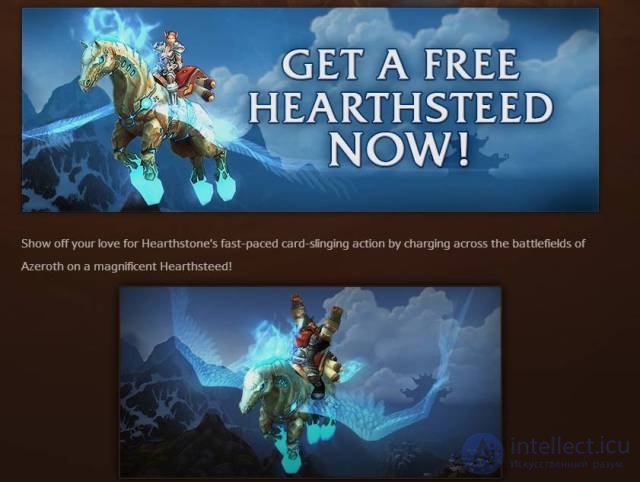
Heartstone + WoW Combo: Special Mount in WoW for those who play Hearthstone.
I want to share a wonderful story: when we just launched and tested my first independent project “ Planewars” , я, не подумав, ввел в игру несбалансированные кораблики. Чтобы их не купили пока я их не настрою, я сделал цены на них в несколько сотен долларов. Идея заключалась в том, что игроки их увидят, облизнутся и захотят купить. Тем временем я их настрою и после этого скину цены. Мы были все еще в режиме тестирования и я посчитал, такое решение допустимо. Кораблики не были сильнее тех, кто уже доступны, но работали немного иначе (об этом в следующем пункте). Корабли я ввел вечером и ушел, а когда вернулся утром, половина игроков уже летала на них, несмотря на их заоблачную стоимость и то, что активных игроков было всего, от силы, пара сотен. Корабли пришлось срочно балансировать и доводить до ума, потому что основным вопросом было «а что они так странно летают и почему их оружие смотрит куда-то в сторону?». Why did this happen? Потому что они были особенными (визуально и по игровой истории), все знали, что это VIP корабли и что летать на них — круто.
В продолжение предыдущего пункта, некоторые товары за реальные деньги действительно могут работать иначе. Как те корабли, которые имели другие параметры, но в сравнении с обычными кораблями, за обычные деньги, их эффективность была такой же. Например, бесплатный корабль имеет 100 скорость и 100 брони. А корабль за деньги имеет 120 брони, но его скорость ниже — 80. По балансу, при прочих равных, ни один из них не сильнее другого. Однако, они разные, и на этой уникальности можно хорошо зарабатывать, не в ущерб обычным игрокам.
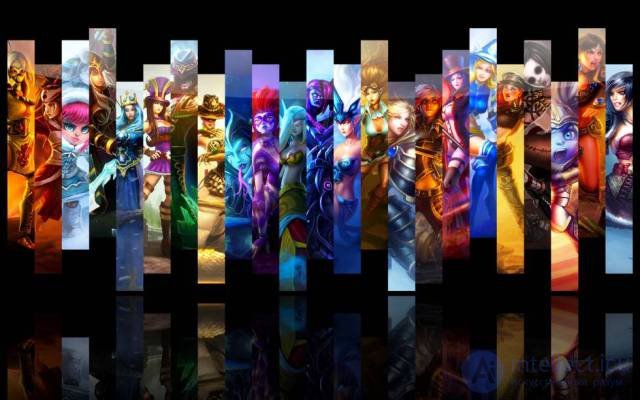
«League of Legends»: коллаж из премиум скинов персонажей
A great example is also the “League of Legends”, where players can play certain characters for free for a week, then rotation - the set of available characters for all players changes. All of them are balanced and more or less equal in strength. But if you are accustomed to some character, or you just like it, or want to try another one that is not available right now - you can buy it for a little money. Players around the world consider this system of monetization one of the most humane and honest in the gaming industry and constantly cite it as exemplary.
Weddings and divorces, holidays, the launch of fireworks, participation in elections, gifts and cards - all this does not directly affect the combat effectiveness of the players and is not necessary to be successful in the game. But you wonder how often these products and services will be bought. Especially if there are friends in the game and there are notifications that someone has a birthday, or the game celebrates a certain day - February 23rd, March 8th, New Year, and so on.

Wedding registration form in Carnage, 1 STC = 30 rubles
If the game has a developed social system, then weddings and divorces will be a permanent phenomenon and, accordingly, a permanent source of income. Moreover, these services and products will not be a single claim, because they are purely voluntary and completely optional.
This is a great way to further monetize, provided that these levels are not obligatory for a visit, their passage does not give paid entry / access players tangible combat advantages. If somewhere at these levels there are some powerful objects, or knowledge, or something else that can strengthen the players, then there must be an alternative way of getting there.
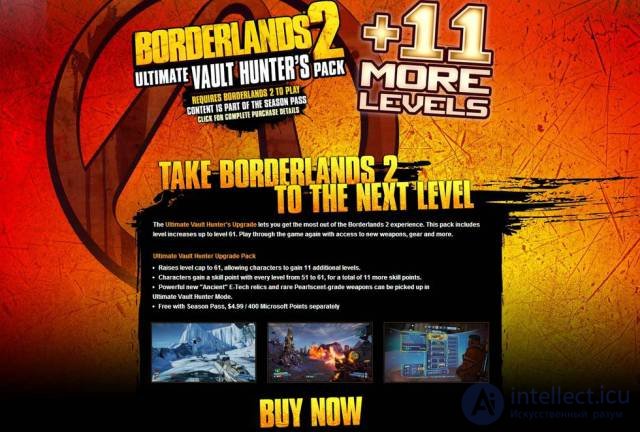
Borderlands 2: offer to buy premium content in the form of 11 additional character levels
An alternative method (free receipt) is possible when players can earn real money in the game (further), or they can enter these levels by collecting some items in the game: special tickets, tokens, or just a large amount of game currency. The greater the difference in the cost of entry, the greater the discontent of ordinary players, but the more valuable such levels will be in their eyes. Balancing entry prices must be carefully, taking into account the interests of all groups of players.
If we are talking about a more or less complex MMO, then there is probably trade there. In the case of some games, there may be exchanges, auctions and direct sales both for game currency and for real. The more players and goods, the more effective their withdrawal from the game and the consumption by the players, the greater the collection, the greater the turnover. The higher the turnover, the higher your income, because with each transaction you will take a commission. If you bargain for goods for real currency and a large base of players, then only with this you will earn good money.
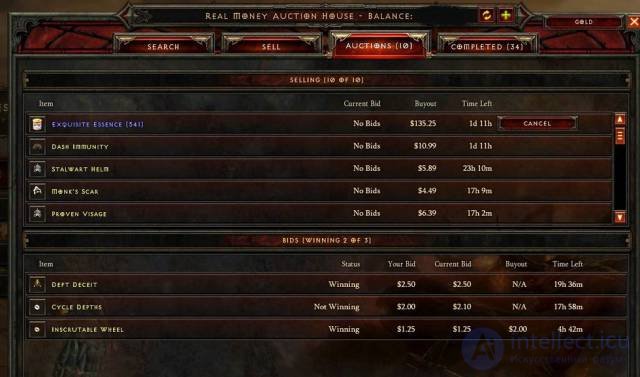
The notorious and disconnected auction from "Diablo 3"
In the case of such an auction / exchange, your task will be to promote trade. Trade can be implemented in a variety of ways: for example, some players get items or create them using craft, then throw them up for auction, selling them to players who do not want to waste time either on hunting or on craft. Thus, they create a base of goods for those who are willing to buy them and earn real money that they can spend on something of their own (for example, access to locations or status items). The game also receives its income in the form of a commission. The main thing to remember is that with such a system in the game, there must be ways to remove goods from the game and not put the availability of goods to the main goal of the game, otherwise you can step on the same rake as Diablo 3.
A wonderful thing that not only gives a good additional income, but also creates additional information channels. Shares can be anything: discounts on certain products, bonuses when buying game currency, special products that are available only during the promotion and so on. The main thing in promotions is their diversity, alternation and unpredictability. The reason is simple: if the players know that they will receive a 20-30% discount on the purchase of currency on the next promotion, then many will be guaranteed to wait and buy the currency. Same with merchandise and special offers. On the other hand, if there are a lot of stocks and they are different, then the players will be constantly tempted by something (provided that you made really interesting and attractive stocks, and not stocks for the sake of stocks).
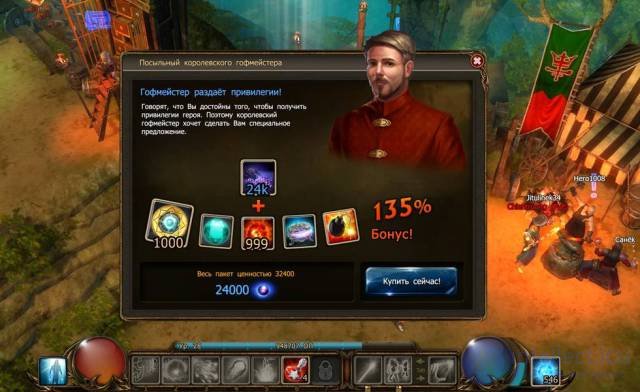
Drakensang: daily special offer
In addition to the promotions, daily special offers work well. For example, in the same Drakensang daily is given not only a bonus, but also a special set of items is offered, available only today at a special price. These items are changed and updated daily, so if someone is not interested in the proposal today, then it is likely that you will be interested in them tomorrow.
There may be two options (or more, but there are still two main ones): direct monetization "head to head" and indirect. Direct - the clan pays monthly tax in real money. It is primitive, not elegant, but it works. An indirect monetization will be a more subtle approach. For example, a clan is required to pay a monthly fee in trophies, which can only be earned for victories in clan wars. What happens in this case? Clans will have to fight if they do not want to be disbanded. If the stakes are as high as the threat of disbanding or serious weakening, then the war between the clans will not only be intense, but also bring good returns.
Negative attitudes on the part of the players should not be: after all, clan gameplay (in 99% of cases) is purely voluntary and very rarely it is the main part of the game. If the prices in the game are properly balanced, then wars and clan participation will be quite accessible to ordinary players.
The principle is similar to the previous point: participation is not necessarily and purely a personal matter. Often there are prizes or awards: in the arenas - some special bonuses, points, medals, experience, money. In poker tournaments - cash prizes or chips, and so on. Monetization can also be either direct (payment of entry, ideal for card games) or indirect (more suitable MMO).
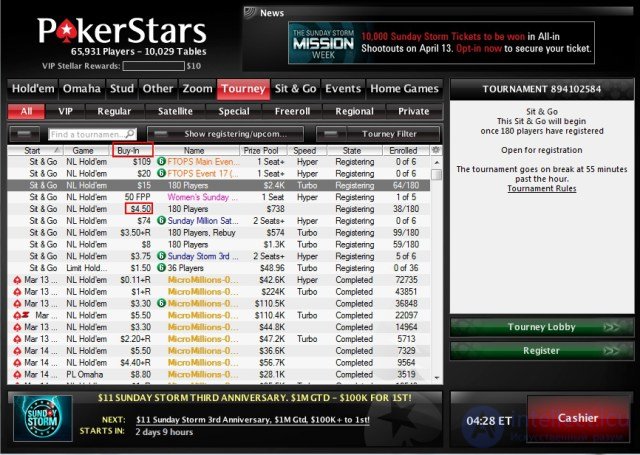
Pokerroom number 1 in the world: entry for points, tickets or $. If there is no money, then there is a big red button.
The first option can be seen in any poker room, the second - for example, in “Drakensang”, where arena monetization is indirect, but very tough and, in my opinion, incorrect (absolute pay-to-win).
It happens that players need to change something in their profile, but they do not have the necessary access. Something changes only in the database, something - through the admin panel. For example, changing the e-mail, renaming the profile, changing the login or something else. On large audiences, these can be frequent requests for which developers usually do not have time. But this, too, can be earned.
Remarkable monetization, invented in ancient times, is known by whom and for what. Monetized people at the expense of punishment were already able then. Online games are just as good: removing penalties can be a great way to make money if you have moderators in the game and the punishment system works well. But here, one should do everything wisely, taking into account the possible consequences, so that there is no impunity and permissiveness for money in the game. If a player regularly violates the rules of the game, has relapses, then the cost should increase. For example, twice for each subsequent similar violation. Then there will be income, and players will know that not everything can be solved for money.
It seems that everything is simple. However, the implementation can be so cruel that the players will leave in anger, having spent hundreds of times more than they had planned. For example, there is a chest in the city, the opening of which costs only one ruble. From it you can pull the very different: something meaningless, money, objects, artifacts, buffs. In fact, this is a “one-armed gangster”, which, as you know, many cause serious dependence and sometimes devastate not only personal, but even family budgets. “Sharpening” (the item is modified with different likelihood: it can be improved, unchanged, destroyed) is also a disguised lottery, and also, if it is balanced inadvertently, can negatively affect players.

Six Guns Lottery: can be free, for chips or monetized
In addition to disguised lotteries, lotteries can be quite ordinary: buying a ticket, choosing numbers and waiting for a rally. The implementation is the simplest, and the yield can be very good. After all, what is the complexity of the offline lottery: you need an audience. And the advantage of the game is that the audience is already there and some part of it is guaranteed to participate.
The usual way of monetization for social games is to donate something inside the game. But in MMOs and in other games, this can be a great tool. What can you give? Buffs, VIP-status or premium (intersects with the gifts described above), energy (if it is in the game), maybe even chips or money, if this is a casino. Giving VIP status usually for social networks or portals, but also in games where the social component is developed and the players intersect with each other, it works perfectly.
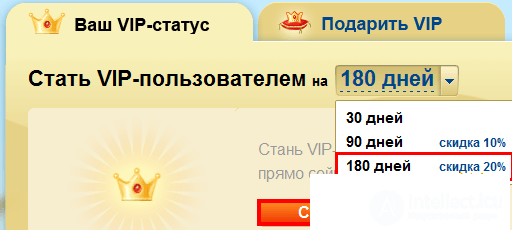
Buying / donating VIP status on My World@Mail.Ru
In an MMO, this can often be a help to clans: better-off players help the ordinary for the good of the whole clan. If such functionality is provided, it will be used from time to time. If it is not there, then no one will help much, because it simply does not occur to the players.
Suppose the players have bags (inventory). They contain a limited number of slots (places) for objects. This is enough for ordinary players, but merchants need more, as they interact with a large number of goods. For them, you can offer bags with an increased amount of space. If the game has time limiting movement, then other players can offer acceleration. And so on, I think the idea is clear: if there are any restrictions, then for an additional fee (one-time or even regular), these restrictions can be reduced. The more important for the player the removal of the restriction, the greater the value of the expansion and the higher its price, respectively.
It looks like the previous point, maybe even could combine them. But here we are talking about the Mirabilit functionality: for example, the game has notebooks or contacts. They are limited to the number of X, but if the player has a lot of friends, then he needs more space in contacts and you can offer him to expand their list for extra money. Such moments in almost any game can be many different and their use as an additional monetization is a matter of the imagination and imagination of the game designer. The only thing that should be taken into account is that if the restrictions are too much and they are too hard, then the players can perceive it negatively and simply leave. So here you need to act carefully and without excessive fanaticism.
This is a set of bonuses that can be anything, from exclusively combat advantages (pay-to-win, which is bad) to exclusively social status (which can be good, but not always interesting for players). The best option in most cases - a set consisting of a variety of bonuses and benefits that may be of interest to various types of players. VIP operates for a limited time, optimally - from two weeks to a month.

Premium status offer in BF4: double experience, accelerated development and so on.
What exactly this can be depends on the game itself. The frame around the avatar or the background behind it is a special color, the icon above the character, the color in the chat, the expansion of usability or functionality (from the points above), the daily free lottery, daily free tickets to tournaments, experience buffs, bonuses when buying currency or discounts buying goods and so on. Options - an infinite number, but in any game you can come up with an interesting set.
Another advantage of VIP / premium is that it (provided that it is limited in time) stimulates players to a more active game. After all, if a player bought it, and it will end in X time, then it is necessary to use it as much as possible.
A frequent way to monetize games that are still under development. It is simple: players are invited to help developers by making donations. In most cases, gives a small penny, but seriously it can not be considered. In addition, if the game already has monetization and players, the presence of the donation button is perceived as moveton. I would recommend to remove it as soon as the game starts to earn at the expense of other ways of monetization. But there is one way that will not conflict - crowdfunding on features.
Honestly, I have never seen such an implementation anywhere. Surely he is somewhere and maybe someone of the readers will share the link. It lies in the fact that in the game or on the website there is a section in which the functionality is listed, the implementation of which will be launched only when the necessary amount is collected. Costs can be different: simple features are cheap, complex ones require large sums. Players fold, see progress (75% out of 100% of the amount collected ...) and this encourages them and others to continue throwing off to see the desired functionality in the game. In the next project we will implement this system and see how viable and relevant it is.
I deliberately do not write about traditional crowdfunding, because this is not the monetization of the game, but the raising of funds for its development.
I do not think that I have described one thousandth of all possible ways of monetization. It is also quite obvious that for each item you can write a separate article, or even a chapter of the book. Maybe someone will ever do it, maybe even ten years later, when there will be more time, who knows.
In addition, I specifically did not describe some ways - such as payment for energy, without which it is impossible to continue the game. This method is used in many games in social networks and I consider it one of the most unworthy, low and unpleasant methods, similar to extortion. The same applies to treating health / injuries for real money and banning the game until the player is healed.
If you have any questions, or there are comments, additions - you are welcome in the comments or you can use the feedback form. As always, I would appreciate an indication of typos. The article was quite large and I could miss something, as usually happens with a chronic lack of time. I hope someone will find it useful, and even if you didn’t find anything new here, I was able to spur your imagination and you will come up with something new that no one has seen before.
In this article I will open a small series of publications on the topic of shareware games (free-to-pla, f2p, hereinafter referred to as f2p) and how to work with this model. Now I will tell fairly obvious and simple things about f2p, the current situation on the market and give some starting points so that the following articles are clear.
I think that all my readers already know what f2p is, but nevertheless, briefly summarize. Now in the world there are four types of monetization of games (and products):
As follows from point four, in f2p games can be played for free. Так почему же огромная часть игроков их ненавидит и проецирует эту ненависть на разработчиков? Прежде, чем ответить на этот вопрос, давайте классифицируем игроков с точки зрения монетизации.
В данном случае это не любители казуальных игр. Это обычные игроки, которые оказались в игре случайно, по рекламе или по приглашению товарища, или просто случайно натолкнулись на ссылку. Они пока еще не поняли, кто они в рамках этой игры и присматриваются, стоит ли тут задерживаться. Далее, они либо уйдут, либо перейдут в следующий тип.
Это игроки, которые по разным причинам не платят, но играют. Их примерно 80-85% в любой игре (и до 90-95% в играх с плохо реализованной монетизацией). Причины, по которым они не платят, самые разные: от странных принципов типа «я не буду платить, потому что меня хотят раскрутить на деньги» до таких причин, как отсутствие возможности платить электронным способом. Большинству же просто жалко тратить деньги на виртуальные товары. Именно часть этих игроки, в основном, распространяют негатив касательно микроплатежей, возмущаются на форумах, ругают разработчиков и формируют оппозицию «бесплатников». Подробнее об этом будет дальше.
Это игроки, которые стали платить. Платят они по-разному, но средний платеж на платящего для хорошо сделанной и настроенной монетизации составляет примерно $50 в месяц. Да, многие из них будут платить по $5, другие по $100; тут прекрасно показывает себя принцип Парето. Донаторы редко бывают недовольны самим фактом условно-бесплатной монетизации, но могут быть недовольны другими вещами, внезапными изменениями цен и так далее.
Хардкорщики с точки зрения монетизации — это самый интересный тип игроков, который создает максимум проблем: они постоянно в игре, они прекрасно играют и при том еще и платят. Есть такое понятие: треугольник время-скилл-деньги, который говорит о том, что игрок либо тратит время, либо деньги, либо выходит в топы за счет умений. Хардкорщики разносят этот треугольник в клочья просто потому, что у них часто очень много времени, они мастера игры и они покупают товары и услуги в игре. Именно благодаря этому типу игроков условно-бесплатные ММО часто получают негативную славу, а ф2п модель считается эссенцией зла и корысти разработчиков.
Иначе говоря, разработчики идеализируют чудо-треугольник скилл-деньги-время и считают его панацеей, забывая о том, что в их игре обязательно найдутся те, кто его поломает и станет практически неубиваемым суперменом (или чем-то аналогичным). Например, они могут посчитать так: неплатящий дойдет до 10 уровня за 10 часов, потратив свое время, но не вложив больше ничего; умелый дойдет за 5 часов, вложив свои навыки и старание; донатор купит пушку и тоже дойдет за 5 часов, вложив деньги.
. . .
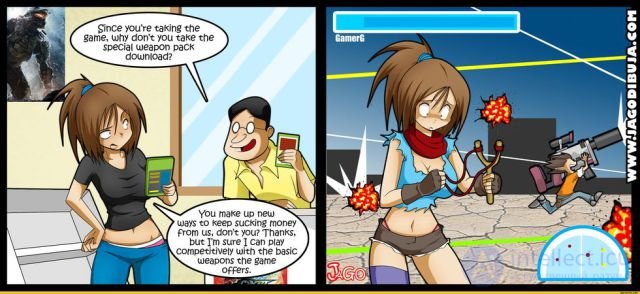
Очень часто в играх деньги дают преимущество донаторам над неплатящими. Даже без какого-то умения, донатор может разнести неплатящего в пух и прах за счет купленной амуниции. Очень хорошо это видно в игре Drakensang , на аренах, когда донатор может одним выстрелом убить неплатящего противника, а неплатящему потребуется сделать попаданий двадцать. И самое печальное, это сделано не случайно: это сделано для того, чтобы а) донаторы больше бы платили и делали бы это охотнее; б) вынудить неплатящих платить, чтобы не быть так называемым «мясом».
То есть игра вынуждает игроков платить. Что вы делаете, когда вас к чему-то принуждают? Вы испытываете недовольство, возмущение, протест. И игроки испытывают то же самое, хоть это и не вы напрямую их заставляете, а другие игроки. Но это вы сделали такую игру, установили такие правила, и игроки больше не ведутся на то, что «это Вася тебя обидел, а мы тут ни при чем» (раньше такое оправдание работало, но теперь уже все поняли, кто на самом деле стоит за такими событиями). Дальше развития могут быть следующими:
И во всех трех случаях какая-то ощутимая часть игроков недовольна.
. . .

Термин появился в пику free-to-play, как циничная пародия на термин, и плотно вошел в обиход и переводится как «заплати и победи». Он распространяется не только на ММО, где донаторы платят и побеждают, но и на однопользовательские игры, в которых игроки ставятся в безвыходные ситуации: либо они заплатят, либо не пройдут дальше.
Как-то, когда мы пытались работать с игровым направлением в mail.ru, я получил интереснейший документ, в котором кружочками расписывалась структура уровней и один из уровней должен был стать неизбежным препятствием, которое можно было преодолеть, только заплатив деньги за оружие или оборудование. Примечание говорило о том, что уровни в игре должны создаваться именно таким образом, и таких узких мест должно быть столько, чтобы человек отдал $20 за все время прохождения игры. Что будет с игроком дальше — не важно, он свои деньги отдал и может идти на все четыре стороны, причем желательно, чтобы это все случилось не дольше трех месяцев. Проще говоря — выжать максимум за минимальное время и выкинуть игрока на помойку. К счастью, с этим проектом и этими людьми мой путь вовремя разошелся, но это уже другая история.
Игроки
продолжение следует...
Часть 1 FREE-TO-PLAY MONETIZATION
Часть 2 - FREE-TO-PLAY MONETIZATION
Comments
To leave a comment
Computer games developming
Terms: Computer games developming